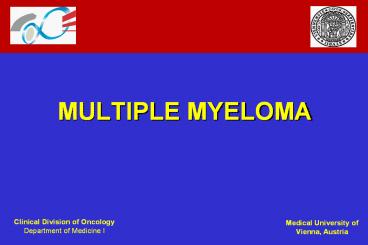MULTIPLE MYELOMA PowerPoint PPT Presentation
1 / 18
Title: MULTIPLE MYELOMA
1
- MULTIPLE MYELOMA
2
MULTIPLE MYELOMA
- Median age at diagnosis, 65 years
- MM accounts for 1 - 2 of all
- malignant diseases
3
MULTIPLE MYELOMA Monoclonal Gammopathies
M.Waldenström (2)
Solitary Plasmacytoma (2)
Others (5)
Smoldering Myeloma (3)
MGUS (55)
Lymphoprolif. Diseases (3)
Amyloidosis AL (12)
Multiple Myeloma (18)
n 882
Adapted from Kyle RA, 1997
4
MULTIPLE MYELOMA Diagnostic criteria for MGUS
- Monoclonal Immunoglobulin (lt3 g/dl)
- No anaemia, hypercalcaemia or renal
insufficiency
- No osteolytic lesions
- Bone marrow infiltration with lt10 plasma cells
- (no plasmablasts)
5
MULTIPLE MYELOMA Long-term Follow-up of Patients
with MGUS
Probability
after 24-38 Years
MGUS
52
Conclusion The risk of progression of MGUS to MM
(or a related disorder)
is about 1 per year.
Kyle RA et al., NEJM 2002
6
MULTIPLE MYELOMA
Indications for therapy
- M-protein in serum and/or urine
- Hemoglobin
- Calcium or creatinine
- Lytic bone lesions
- Extramedullary plasmacytoma
7
MULTIPLE MYELOMA
Primary Treatment
gt age 65
lt age 65
Standard-dose chemotherapy
High-dose therapy
(high-dose melphalan, followed by
autotransplantation)
(melphalan/prednisone or combination
chemotherapy)
8
MULTIPLE MYELOMA STANDARD-DOSE CHEMOTHERAPY IN
MULTIPLE MYELOMA
Single (MP) vs. combination chemotherapy (CCT)
n6,633 (27 trials)
Therapy Response ()
MP 53
Plt.00001 CCT 60
No difference in survival No subsets with benefit
Myeloma Trialists, JCO 1998
9
MULTIPLE MYELOMA TREATMENT
Interferon-alpha
Therapy Relapse-free survival Overall
survival at 5 years () at 5 years
() IFN 23 31 No IFN
16 28
P.00001
P.008
Meta-analysis of 20 trials (n 4000)
Myeloma Trialists, Br J Haematol 1998
10
STANDARD-DOSE THERAPY IN MM
Second-line treatment
Duration of remission / plateau-phase
- gt 6 months
- Retreatment with
- initial therapy
lt 6 months VAD ID, VRID VMCP /
VBAP DCEP Thalidomide Thal / Dexa
11
MULTIPLE MYELOMA
12
STANDARD versus HIGH-DOSE THERAPY IN MM
Study
Therapy
CR
OS(months)
P
Attal (1996) VMCP/VBAP 5 44 MEL140TBI 2
2 57 lt.001 Barlogie (1997)1 Conventional NA 4
8 MEL200x2 40 62 .01 Palumbo
(1999)1,2 MP 5 48 MEL100x2/3 47 56 lt.01
Lenhoff (2000)1 Standard dose NA 44 MEL
200 34 60 .001 Child (2001) ABCM 14 42
MEL200 53 52 lt.05
1 Pair-mate analysis 2 Patients at gt60 years of
age
13
PROGNOSTIC FACTORS FOR SURVIVAL AFTER HIGH-DOSE
THERAPY
P
RR
No -13/13q- 0.4 lt .0001 B2M lt 2.5
mg/l 0.6 lt .0001 lt 12 months prior
SDT 0.7 .0001 CRP lt 4.0 mg/l 0.7 lt
.0002 Sensitive disease (SDT) 0.7
.0002 Days to 2nd HDT
0.4 .001 Any 2nd HDT 0.02 lt .0001 Non-IgA
isotype 0.7 .002
"Arkansas 1000 "
Desikan et al., Blood 2000
14
MULTIPLE MYELOMA SINGLE versus DOUBLE
AUTOTRANSPLANTATION
IFM 94 (Attal et al.)
MEL140(TBI)
MEL140x2(TBI)
CR 34 35 NS Median EFS 31
months 37 months .03 EFS at 6
years 19 28 Median OS 50 months 58
months .02 OS at 6 years 26 46
Interim analysis, January 2002
15
CHROMOSOME 13q14 (FISH) AND SURVIVAL IN MM
Study
Therapy1
n
OS(months)
P
13q14
Perez-Simon (1998) SDT normal
32 60 deleted
16 14 .001 Zojer (2000) SDT
normal 51 60
deleted 46 24 lt.005 Fonseca
(2002) SDT normal
149 51 deleted
176 35 .02 Worel
(2001) HDT normal
17 72 deleted
11 24 .012 Facon (2001) HDT
normal 68 65
deleted 42 26 .0001
1 SDT, standard-dose chemotherapy HDT,
high-dose therapy (MEL autologous PBSCS)
16
PROGNOSTIC MODEL IN MM
Chromosome 13q14 (FISH) and ?2M
FEATURES MEDIAN SURVIVAL
Standard-dose chemotherapy
No del13q and B2M lt 4 mg/l Del13q or B2M gt 4
mg/l Del13q and B2M gt 4 mg/l
Königsberg (JCO 2000)
102 months 46 months 11 months
High-dose chemotherapy
gt 111 months 47 months 25 months
No del13q and B2M lt 2.5 mg/l Del13q or B2M gt
2.5 mg/l Del13q and B2M gt 2.5 mg/l
Facon (Blood 2001)
17
THALIDOMIDE IN ADVANCED AND REFRACTORY MM
- 169 patients (76 with prior high-dose therapy).
- Thalidomide at a dose of 200-800 mg daily.
- Objective responses (25 tumor regression) in
- 37 of patients, with near-complete or
complete - remissions in 14.
- Two-year event-free and overall survival rates
were - 20 and 48, respectively.
Barlogie et al., Blood 98 492, 2001
18
TREATMENT OF MULTIPLE MYELOMA SUMMARY
- High-dose chemotherapy is superior to
standard-dose chemotherapy in MM (improved CR
rate, prolonged event-free and overall survival). - The current standard of high-dose therapy is
melphalan 200 mg/m2 followed by autologous
peripheral blood stem cell support, with some
evidence suggesting a beneficial role of tandem
transplantation. - Cytogenetics has emerged as an important
prognostic factor in MM, and deletion of
chromosome 13q14 is a major independent parameter
predicting for short survival of patients with
MM. - Since patients with del13q14 do poorly with
current treatment approaches, they should be
considered for enrollment in clinical trials
evaluating novel agents and treatment
strategies.

